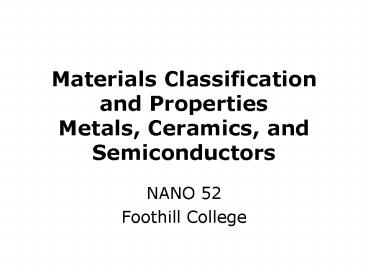Materials Classification and Properties Metals, Ceramics, and Semiconductors - PowerPoint PPT Presentation
1 / 16
Title:
Materials Classification and Properties Metals, Ceramics, and Semiconductors
Description:
Properties of Materials. Physical. Mechanical. Chemical. Thermal. Electrical. Optical ... shear, torsion. Deformation. Hardness. Chemical Properties ... – PowerPoint PPT presentation
Number of Views:1837
Avg rating:3.0/5.0
Title: Materials Classification and Properties Metals, Ceramics, and Semiconductors
1
Materials Classification and PropertiesMetals,
Ceramics, and Semiconductors
- NANO 52
- Foothill College
2
Properties of Materials
- Physical
- Mechanical
- Chemical
- Thermal
- Electrical
- Optical
3
Physical Properties
- Strength
- Ductility
- Melting point
- Glass transition
- Density
4
Mechanical Properties
- Stress strain behavior
- Strength
- Tensile properties
- Compression, shear, torsion
- Deformation
- Hardness
5
Chemical Properties
- Acid - base
- Reactivity
- Corrosion
- Oxidation
- Passivation
6
Thermal Properties
- Heat conductance
- Heat capacity
- Thermal expansion
- Annealing temperature
- (Melting point, softening point)
7
Electrical Properties
- Electrical conductivity
- Electrical resistance/impedance
8
http//www.corrosionsource.com/
9
Metal Structure / Bonding
- Metallic bonds
- All metals are made up of a vast collection of
ions that are held together by metallic bonds. - A metal atom has a positive nucleus with negative
electrons outside of it. - In a solid, each atom loses the outermost
electron, which takes part in bonding. - They form a lattice of regularly spaced positive
ions. Each ion has no control over its bonding
electron.
http//www.chm.bris.ac.uk/pt/harvey/gcse/other.htm
l
10
Examples of Ceramics
- Clay, Minerals, Salts and Oxides
- Technical Ceramics can also be classified into
three distinct material categories - Oxides Alumina, zirconia
- Non-oxides Carbides, borides, nitrides
- Composites Particulate reinforced, combinations
of oxides and non-oxides.
11
Ionic Bonding in Ceramics
- Ceramic materials are formed from ionic bonds
within their constituent atoms, oxides and salts. - Ionic bonds are not nearly as ductile as
metals, causing ceramics to be brittle.
12
Metallic vs. Ionic Bonding
- Much easier to deform materials with metallic
than with ionic bonding. Why?
- Sliding atom planes over each other (deformation)
very unfavorable energetically in ionic solids! - ? metals are ductile ceramics (ionic) are
brittle
13
Semiconductors
14
Semiconductors
http//worldwatts.com/silicon_semiconductor.html
15
Semiconductors
- In solid state physics and related applied
fields, the band gap is the energy difference
between the top of the valence band and the
bottom of the conduction band in insulators and
semiconductors.
16
Semiconductors
- The ease with which electrons in a semiconductor
can be excited from the valence band to the
conduction band depends on the band gap between
the bands, and it is the size of this energy
bandgap that serves as an arbitrary dividing line
(roughly 4 eV) between semiconductors and
insulators. - Electrons excited to the conduction band also
leave behind electron holes, or unoccupied states
in the valence band. Both the conduction band
electrons and the valence band holes contribute
to electrical conductivity. - The holes themselves don't actually move, but a
neighboring electron can move to fill the hole,
leaving a hole at the place it has just come
from, and in this way the holes appear to move,
and the holes behave as if they were actual
positively charged particles.































